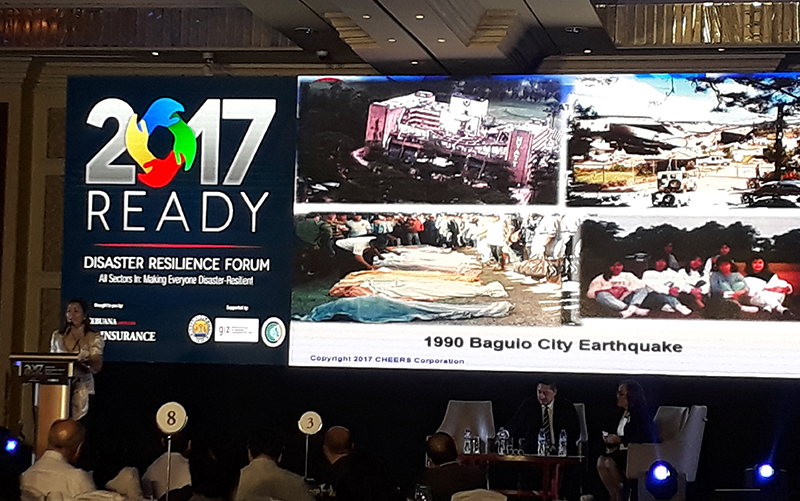Baguio quake survivor shares 5 tips to survive disasters

Sandra Sanchez Montano sharing her experiences as a survivor of the 1990 magnitude 7 Luzon earthquake that killed more than 1,600. Philstar.com/Deni Rose M. Afinidad-Bernardo
MANILA, Philippines — It seems ominous but days before a 6.3-magnitude earthquake hit Luzon on August 11, a survivor of the 1990 Baguio killer quake shared her story to warn her fellow Filipinos about disasters and to share tips on how to be resilient in the face of calamity.
Sandra Sanchez Montano can still recall how a Baguio vacation turned into a nightmare as she spent three days under the rubble with no food and water. Among the last things she remembered before passing out was praying to God that if she does not come out alive, at least, let her family find her body.
Her body was later found by strangers and was put in a pile of dead in Burnham Park. Fortunately for her, she was revived back to life.
But years after that, the trauma lingers. “There were times when my family thought I was raped because the trauma, the memory of the dead bodies that were with me, won’t leave my mind,” she recounted in a recent disaster resilience forum organized by Cebuana Lhuiller Insurance Solutions.
In her quest to save lives, Montano became a nurse and founded Community Health Education Emergency Rescue Services (CHEERS), a non-government organization that offers trainings and courses from basic first aid to emergency response. Among CHEERS’ programs is an online platform developed in partnership with Overseas Workers Welfare Administration (OWWA) to update overseas Filipino workers all over the world about disasters in the Philippines.
“The Philippines is the number one most disaster prone nation in the world,” Cebuana Lhuiller’s research says.
“A study made by a risk analysis firm found that eight of the ten cities most at risk to natural hazards are in the Philippines. These cities include Tuguegarao, Lucena, Manila, San Fernando in Pampanga, Cabanatuan in Nueva Ecija, Batangas, San Carlos, and Naga.”
According to the research, the Philippines’ vulnerability to environmental disasters and climate-related calamities is driven by, among others, its geophysical location, climate and topography. Apart from lying
within the Pacific Ring of Fire, the Philippines also faces the Pacific Ocean wherein most storms get formed. It is exposed to hazards of climate change such as sea level rise, coral bleaching, and extreme typhoons, floods, landslides and droughts. It suffers from deforestation, having lost already a third of its forest.
As an archipelagic nation, a large percentage of Filipinos live in islands and low-lying coastal areas. In times of disasters, these Filipinos are the first ones to get isolated. In urban communities, thousands of households are constructed along the 100-kilometer West Valley Fault, which traverses parts of Bulacan, Metro Manila, Cavite and Laguna. This fault is said to be ripe for movement and could trigger destructive earthquake and possibly tsunamis.
Underdevelopment and current economic realities compound Filipino communities’ vulnerability to disasters and calamities. Poverty drives many households to live in more dangerous areas such as those near riverbanks and other areas prone to flooding. Informal settlers and poor communities in rural areas often live in rapidly constructed housing and shelters too weak to withstand floods, storm surges and strong winds.
Unfortunately, high-risk communities have inadequate disaster preparedness and evacuation plans. When hit by disasters and calamities, these communities suffer from huge damage to their properties, livelihood, jobs, health and wellness. Others lose their lives and/or their loved ones. Thousands of families, including women, children and the elderly are severely affected.
To avoid consequences like these, Montano gave the following tips hauled from her experience as a disaster survivor and as a calamity resilience advocate:
1. Address the trauma
Besides physical first aid, among the first responses that should be given to disaster victims is psycho-social healing from trauma. This, said Montano, can be done through counseling, workshops, and arts and crafts that could show victims that there is life after a disaster.
2. Rebuild schools or give books and toys to kids
All efforts, Montano said, should be made to bring kids back to school as soon as possible or to give them toys and books because based on her own experience, toys and books can help kids feel their lives are going back to normal.
3. Write a love letter or a letter of encouragement to victims
If you are donating books and toys, write a love letter to go with your donations to make the victims feel loved and cared about. If you do not have anything to donate, a letter of encouragement will do.
4. Plant disaster-resilient crops or include disaster-resilient products in your survival kit
In the Asia Pacific, 60 percent of Filipinos always experience hunger, said Montano. Thus, to be part of food security, CHEERS encourage farmers to plant cassava, monggo and camote because these are climate-change resilient crops that have been developed into 36 products like polvoron and hopia that CHEERS is lobbying to be included in the Asian go bag or survival kit.
Her organization, she said, is developing an energy bar using Davao tablea and banana and working on Halal certification. She said disaster-resilient food like these can mitigate even the Philippines’ other “disasters” such as heart health problems, obesity and malnutrition.
5. Lift everything to God
“Disasters have already been foretold in the Bible,” said Tolentino. “It’s not raining when God asked Noah to build the ark, so we should be able to build our own arks…If you have your kikay kit, you should have your go bags, too…God uses our greatest pain to ready us for the greatest part of our life.”



















